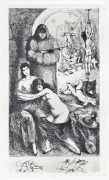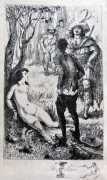 The Marquis de Sade’s story of the lovers Léonore and Clémentine is one of the three interwoven tales of his first novel, Aline and Valcour, written in 1795 just before he was imprisoned in the Bastille a few months before the French Revolution. As with all his works, it is remarkable that it survived the chaos of the Revolution, and just like his more famous Justine and Juliette, it was officially banned in 1815 and only republished legitimately in the mid-twentieth century.
The Marquis de Sade’s story of the lovers Léonore and Clémentine is one of the three interwoven tales of his first novel, Aline and Valcour, written in 1795 just before he was imprisoned in the Bastille a few months before the French Revolution. As with all his works, it is remarkable that it survived the chaos of the Revolution, and just like his more famous Justine and Juliette, it was officially banned in 1815 and only republished legitimately in the mid-twentieth century.
Young Léonore elopes with her beloved, Sainville, but is abducted during their honeymoon in Venice, sold to pirates, and transported to Africa. There she meets Clémentine, and the two women become staunch friends. After escaping from the clutches of a cannibal king they return to Europe, where they are more kindly treated by a troop of devil-worshipping Bohemians than by the magistrates, noblemen, and ecclesiastics – including officers of the Grand Inquisition – who seek to victimise them as they travel through Portugal and Spain. Nobody can accuse Sade of limited imagination!
Luc Lafnet, using his Viset pseudonym, produced five detailed engravings for this 1930 edition of Léonore et Clémentine, four of which were also produced as colour versions for the de luxe edition.
Au Cabinet du Livre published Léonore et Clémentine in a limited numbered edition of 745 copies, of which 100 included the colour engravings.










